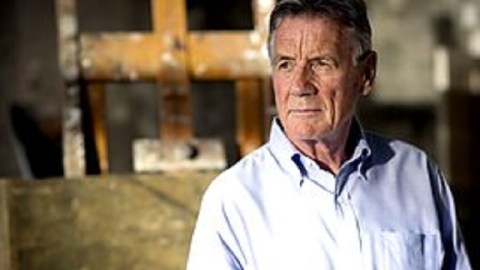How Michael Palin Broke the Silence of The Helga Paintings

Not many art stories make the cover of both TIME and Newsweek in the same week, but the revelation of Andrew Wyeth’s infamous “Helga Paintings” in 1986 caused a news stir that spilled outside the confines of the culture sections. The tale included all the ingredients of a ripping yarn for the masses—deceit, fame, big money, and a pinch of sex to spice things up. The “Helga” of the “Helga Paintings,” Helga Testorf, fled the paparazzi at the time and maintained her silence both about the paintings themselves and the nature of her relationship with Wyeth before, during, and years after their creation. In the BBC Program Michael Palin in Wyeth’s World, former Monty Python member and amateur art historian Michael Palin finally entices Helga from the shadows to speak about the paintings and the painter. What she shares raises new questions about the works as well as what the legacy of Andrew Wyeth should be.
Wyeth first met Helga Testorf in 1970, when she began working as a nurse for Wyeth’s neighbor and sometimes subject, the terminally ill Karl Kuerner. At the time, Wyeth churned out a prolific number of works that increasingly bore the “Wyeth” brand. Wyeth’s wife, Betsy, oversaw the lucrative family business in every detail from documenting and even titling every last preparatory sketch or finished tempera to keeping a tight grip on the reproduction and sale of Wyeth’s oeuvre. Sometime in 1971, Wyeth began sketching and painting Helga in the sanctuary of the Kuerner family farmhouse. For the next 15 years only Wyeth and Testorf knew of the almost 250 works kept secret from the world and especially Betsy Wyeth, who was kept unaware by Wyeth’s continual production on the side of works for public consumption.
The “Helga Paintings” represent one of the most unique relationships between an artist and a model ever in terms of longevity and intimacy. Fifteen years of working essentially every day for as much as 8 hours a day is an extraordinary amount to time to spend on a single subject. But in dealing with the subject of Helga, Wyeth found an incredible range of human emotion. (A slide show of selected works from the “Helga Paintings” can be seen here.) In a work such as Braids (1979), you can almost see the model thinking as Wyeth captures subtleties in her facial expression. As psychologically revealing as the “clothed” portraits are, the nudes that have raised the most scandal may lay the subject (and the artist) bare emotionally.
The full frontal nudity of some of the nudes opened Wyeth and Testorf up to rumors of infidelity to their respective spouses, but in the examination of Testorf’s physical “landscape” in such fine detail, Wyeth reached a depth of psychological portraiture rarely seen on such an epic scale outside of the long-term self-portraiture of Rembrandt or Van Gogh. When Betsy Wyeth was asked what the newly revealed “Helga Paintings” were about, she simply responded, “Love.” In a 1993 interview, Wyeth echoed his wife’s remarks: “Well, of course, it was love. Everything I paint is about love. Why paint something you don’t know, you don’t love?” The question of what kind (or kinds) of love, however, still hovers over the pictures and Wyeth’s legacy.
And that’s where Palin’s show enters the story. Although best known for his madcap antics with Monty Python, Palin’s also a (mostly) serious historian and explorer of cultures. Palin’s earlier art history documentary, 2005’s Michael Palin and the Mystery of Hammershoi, explored the dark, moody art of the elusive Danish artist Vilhelm Hammershoi, so, clearly, Wyeth’s dark, moody side—so present in the Helga Paintings—easily appealed to Palin. (Palin’s Wyeth documentary first aired on December 29, 2013 in the UK and is still unavailable in the United States.) In one of those painfully staged moments of documentaries, Palin “surprises” Helga at home about halfway through the hour-long program. He quickly asks her to recall the circumstances of how Wyeth first began to paint her. “It was expected of him to make paintings like pancakes,” she says, alluding to the pressure placed on Wyeth by his wife Betsy to continue to create images consistent with the Wyeth “brand,” which Helga dismisses as “postcards.” Wyeth “needed to paint for himself… He needed to feed himself,” she emphasizes. Wyeth needed to create art outside the world of the critics, including, presumably, Betsy. “He was the best critic there was,” Testorf says of her deceased friend and employer. “And, together, we critiqued, believe me. I learned a lot. Andy listened to me, too.” Throughout the interview, Testorf takes credit for a collaborative role that began with an artist and model relationship and that continued as an artist and assistant relationship until Wyeth’s death in 2009.
Moving on to the moment of the revelation of the paintings in 1986, Palin asks Testorf if she was surprised. Helga replies that Wyeth promised her that the paintings wouldn’t be shown until after his death. Why, then, did he reveal them during his and her lifetime? “I think he was caught in something to let it come out,” Helga says vaguely. “It was his promise, but Mother Nature had other plans.” Palin quickly moves on to the more salacious aspects of the tale. “They didn’t know any better,” Helga responds to the charge that she was Wyeth’s mistress. “They didn’t know our language. We were not talking about those things. We had better things to talk about.” After giving sunrises, sunsets, and moons as examples of the “language” she and Wyeth shared, Helga says mystically, “Nature has all the answers.” Sex “has nothing to do with it,” Helga says emphatically. “The nude is the most holy thing. If you can get next to it, it is a divine spirit. It’s soul. He paints the soul.” Listening to Helga Testorf speak at that moment, I felt like Wyeth was speaking from beyond the grave as she echoed his voice from their countless conversations over the nearly 40 years they knew each other.
Thus, Palin leaves the standard storyline intact: 15 years of secrecy, the moment of awkward revelation, quickly followed by the media frenzy and sale of the complete series to millionaire Leonard E.B. Andrews, who exhibited the works around the world before himself selling the collection to a Japanese collector in 1989. However, as Los Angeles Times critic Christopher Knight recounted at the time of Wyeth’s death in 2009, the story might not be that simple. Knight remembers Andrews as essentially a con artist who orchestrated with Wyeth’s help the publicity that maximized the profitability of the sale and subsequent exhibitions. Starting with a piece in the September 1986 issue of Art & Antiques, Andrews peddled the “Helga Paintings” through press releases that Time and Newsweek used for their cover stories (neither, as Knight points out, written by those magazines’ art reporters). Andrews himself found his story appearing in People Magazine, not your typical culture outlet. Knight accuses the Wyeths of actually approaching Andrews initially, with Andrews agreeing to buy not just the paintings, but also the lucrative copyrights, which gave him the profits on reproductions sold during the exhibitions, including a rare National Gallery of Art exhibition of a living artist in 1987. “Ten short months after the tour ended, Andrews sold ‘the national treasure’ [of ‘Helga Paintings’] to an unidentified Japanese buyer, for $40 million to $50 million,” Knight reports. “With the help of a tax-exempt array of nonprofit art museums, the collector’s three-year profit on the phony art-and-sex scandal has been estimated in excess of 600%.” So, were the “Helga Paintings” about “love” or profit?
Anyone who knows the story of the Wyeth art dynasty knows their secretive nature. As Palin’s documentary vividly demonstrates, Jamie Wyeth, Andrew’s son and continuer of the family tradition, literally lives on an island. Jamie speaks to Palin about his father’s art, but Helga Testorf’s interview steals the show. Andrews the buyer of the “Helga Paintings” died in January 2009, just weeks before Andrew Wyeth passed away. Conspicuous by her silence in Palin’s documentary is Betsy Wyeth, herself now in her nineties. If Betsy’s unable or unwilling to speak, Helga Testorf emerges as the last witness to the story of the “Helga Paintings.” But is Helga a reliable witness, or is she simply repeating the “company line” to keep the Wyeth mythology alive? If Knight’s allegations are true and Helga’s the last true believer in the romantic version, is she a dupe, a victim of the artist? The “Helga Paintings” were to be revealed upon Andrew Wyeth’s death, but 5 years after his passing, they’re still as mysterious as they were back in 1985. Palin deserves a lot of credit for getting Helga Testorf to give her side of the story at last, but it raises the question of how true her or the Wyeths’ side really is. Undoubtedly, “The Helga Paintings” are really about “love,” but whether they’re about love of art, love of the human form, love of a friend, love of a mistress, love of money (the root of all evil), or some or all of the above, I’d love to know.
[Many thanks to friend Dave, my source for all Wyeth-related news, for telling me about the Palin documentary.]





